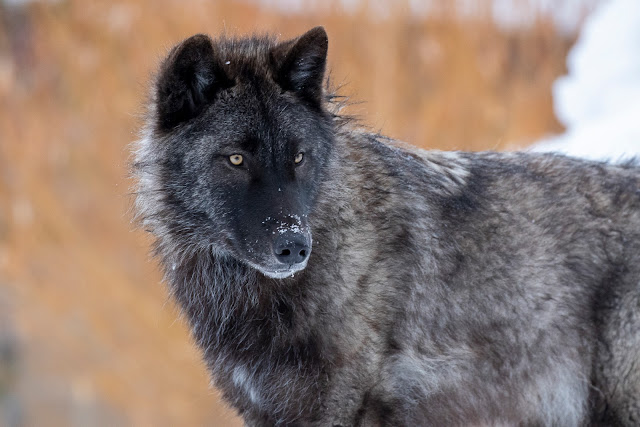 I have long wished to see the snow-covered landscape of Yellowstone National Park. In late January 2020, I began this long-anticipated trip a day early to avoid any weather related delays. My trip was led by John Gerlach, a long time resident of West Yellowstone (and an accomplished photo instructor).
I have long wished to see the snow-covered landscape of Yellowstone National Park. In late January 2020, I began this long-anticipated trip a day early to avoid any weather related delays. My trip was led by John Gerlach, a long time resident of West Yellowstone (and an accomplished photo instructor).Flying over the plains of Montana approaching the Bozeman airport, I was concerned by what I saw beneath me. The only snow visible from 35,000 feet was hidden in the lee of small ridges. Would Yellowstone be barren of snow? I over-nighted in Bozeman and boarded the Karsch Stage's bus at 4:30 am for West Yellowstone. As the bus approached the Big Sky ski resort for an inter-mediate stop, my fears were gone - maybe not deep snow, but enough to suggest that at the higher elevations, there would be deep snow. Nothing to worry about; and, the forecast was for mild temperatures between 12 and 30 degrees. Perfect.
Arriving in West Yellowstone at 08:00 am, the streets were snow-covered. A hearty breakfast at Three Bear Hotel told me that John Gerlach had picked a great place for our group's lodging and food.
 The Gerlach program did not begin until after dinner, but I had plans to fill the day. It was a short two block walk over to the Grizzly and Wolf Discovery Center in West Yellowstone. My goal was to get some practice in action photography. I scouted in the morning, and returned after lunch with camera.
The Gerlach program did not begin until after dinner, but I had plans to fill the day. It was a short two block walk over to the Grizzly and Wolf Discovery Center in West Yellowstone. My goal was to get some practice in action photography. I scouted in the morning, and returned after lunch with camera.The center has multiple groups of grizzly and wolf. For both species, they have large outdoor runs that are kept meticulously clean. The outdoor run is prepared with treats and natural scents before a group of 2 or 3 animals is allowed out. They enter stimulated to explore the area, and the local ravens are actively interacting with them, too, as they look for food scraps.
Let's look at the grizzly first. The keepers hide treats under some logs in the enclosure.
One of my first lessons was how difficult it is to see a bear's eyes. There are nearly no whites to see, and they are very dark. Another challenge is separating the bear's shape from the gang of ravens. Patience.
Another lesson is using a wide open lens aperture to keep the background indistinct. The bear enclosure had limited angles where the fencing is unseen. It was still very useful practice.
The wolf enclosure was also fruitful, with the wolf's fleetness offering challenging but rewarding photography. The eyes are easily seen, and capture your attention. This wolf was prone to bursts of running, that often were free of any elements of the fencing.
Most of the wolves were towards a blackish color, and this one particularly attracted me.
On my first day at the center, it often snowed. In the bursts of snow, it became impossible to lock focus on the eyes of a running wolf. The camera always locked on a large snow flake closer to the camera. On the last day of the Gerlach program, we returned to the Grizzly and Wolf Discovery Center, giving me another opportunity with moments free of snow.
There were other attractions in the discovery center. The Great Horned Owl pair were attractive, but the enclosure always ruined the photo with fencing. There was an indoor space with River Otters and a fish pool. I'd wondered if the fish were to feed the otters. No, I was told; that would have made for some wild viewing.
As it was, I did get a short clip of a lone River Otter while using my mobile phone. I'd hope to see the otters on the Yellowstone River later in the week. Had to settle for seeing their tracks in the snow.
One last goal on my trip was getting a good image of one of the Ravens. It's hard to get the dark eyes and tones of their feathers. On the last day, back at the Grizzly and Wolf Discovery Center, I closed my visit out with checking off the Raven from my photo list.
I will soon provide coverage on my five days in the winter wonderland of Yellowstone Park. You will see that the park has a different personality in winter. Snow and ice create a new landscape. A vastly smaller number of visitors present cleaner landscapes. The bison are plentiful and present many interesting portraits. The winter light is less harsh than summer. I loved it and only want to experience it again.
Paul Schmitt






Marvelous shots! I love the wolf closeups with the gray and white palette. We saw ravens at Grand Canyon, too.
ReplyDelete